www.industryemea.com
15
'24
Written on Modified on
MTU: HOW GAS ENGINE POWER PLANTS CAN CLOSE THE GAP
Mature, industrialized countries share a legacy of large-scale controllable power plants securing a reliable supply based on a well-established infrastructure.
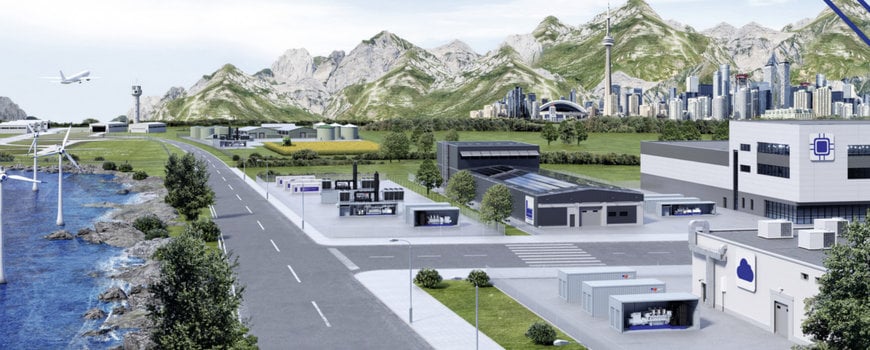
The transition towards sustainable yet intermittent Renewable Energy Sources (RES) has changed the requirements made on controllable conventional power plants: from demand-driven supply towards representing a ‘resilience backbone’ bridging the gap between intermittent power generation from RES and demand with greater flexibility.
In the past, the ‘basic setup’ of an energy system was characterized by conventional large-scale, centralized power plants providing baseload capacity, complemented by peak-load natural gas turbines to cover demand at any given point in time. This ‘traditional’ system was based on the following key principles:
- Demand is highly predictable (e. g. standard load profiles largely applicable over a wide customer range).
- Installed controllable power supply is sufficient to cover demand at any time (incl. peaks).
- Transmission and distribution grids are designed and sized to transport electricity from central power stations to reliably satisfy regional demand.
A new era begins: Energy systems are transforming towards sustainability by increasingly utilizing intermittent and decentralized Renewable Energy Sources.
However, the energy system is transforming towards sustainability in an effort to tackle the challenges of climate change (cf. Figure 1). More and more distributed, intermittent renewable capacity is installed, which changes requirements for controllable conventional power plants. From a power generation perspective, conventional power plants must, for example, step in to meet demand during longer periods of bad weather with cloudy skies and little wind, when renewables can only contribute less.
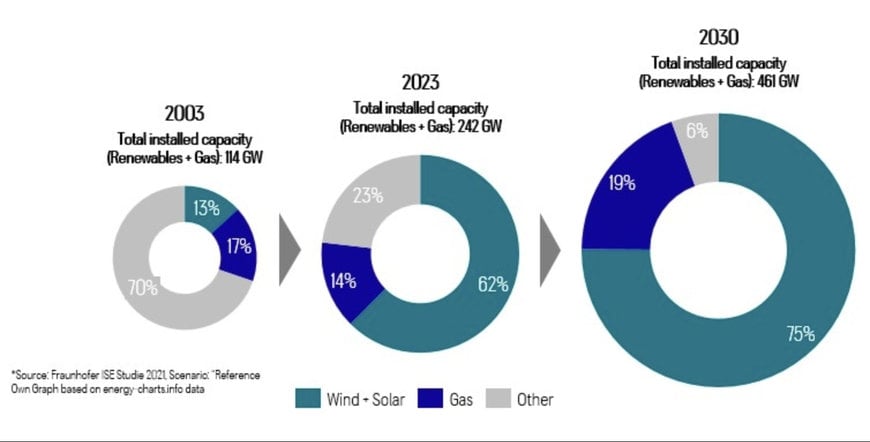
Figure 1: Installed Power Generation Capacity in Germany
Meanwhile, customer consumption patterns are also changing. Electrification of transportation and heating have been increasing in recent years. Overall demand and peak load have changed significantly over the last 20 years. Between 2015 and 2023, electricity demand in Germany was around 460 to 500 TWh per year, with a slightly decreasing trend in recent years. However, depending on the share of hydrogen, the rate of direct electrification, and improved efficiency in the future, electricity demand in Germany is expected to double or even triple between now and 2045 (cf. Figure 2).
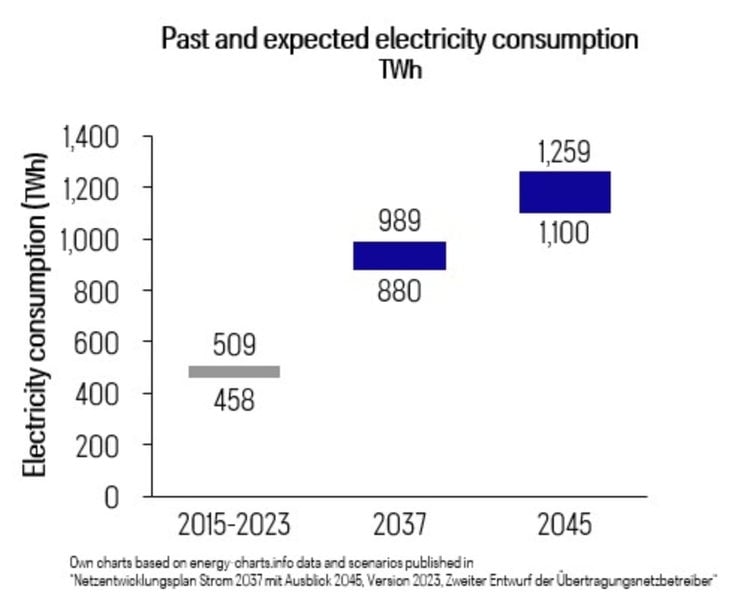
Figure 2: Actual and Expected Electricity Consumption in Germany
Furthermore, in networks involving high numbers of PV home systems (with and without battery storage), consumers can be self-sufficient and still draw power from the grid during certain hours or in bad weather. Conventional power generation must still cover these events when large-scale storage systems are no longer an alternative due to their restricted capacity.
While combustion technologies were the heart of the power system in the past, they are now becoming a key enabler, filling the gap between demand and renewable energy production. Consequently, they facilitate the increased integration of intermittent RES into the power system, thereby accelerating the energy transition even further.
However, building up new intermittent renewable energy resources presents its own challenges. The great dependency on wind and solar energy leads to capacities being built on a large scale, requiring vast areas to capture as much energy as possible. Point of generation and demand tend to be inherently divergent in these areas.
Large-scale renewable power plants are usually located well away from regions of high demand. Consequently, the power must be delivered to the point of demand, with an ageing transmission and distribution infrastructure struggling to integrate and bear a higher share of renewables. For example, resource availability means that wind power generation facilities are mainly situated in the north of Germany, while most heavy industry lies in the west and south of the country. As a result, the power must be delivered to these locations, resulting in a need to extend the transmission grid, which in turn requires substantial investment to be covered by the final consumer, and also takes years to plan and build. For example, long approval times and resistance from within the population make the process lethargic, with construction and extension of the power grid often lagging behind the change in load and generation patterns.
If the grid is unable to cope with all the power injected, renewable power generation can become subject to redispatching, while conventional power plants in high-load areas ramp up. This means that renewable power plants have to decrease their output in response to grid constraints, while conventional distributed capacities, operating independently of the weather in high-load regions, can be an alternative solution to cover renewable shortcomings and peak loads until the infrastructure has been enhanced and/or local RES generation catches up, thus lowering the need to transport RES energy over great distances.
Mind and close the gap: Gas power plants close the gap between intermittent RES and increasing demand.
The German government published their Kraftwerksstrategie in February 2024. New gas power stations are in planning to pave the way towards a reliable, climate-neutral power system. Compared to lignite or hard coal, gas combustion has lower CO2 emissions and can become CO2-neutral by burning green hydrogen instead of methane. Gas power plants are also more flexible than coal technologies in terms of start intervals and load changes.
Two types of gas technologies are generally to be considered: Turbines (namely Combined Cycle Gas Turbines (CCGT) & Open-Cycle Gas Turbines) and Reciprocating Internal Combustion Engines (ICEs, namely Medium Speed Reciprocating Engines & High Speed Reciprocating Engines).
Turbine power plants are the technologies of choice for large power generation facilities. High runtime at full load and only a few starts per year result in low Total Cost of Ownership (TCO) and Levelized Cost of Energy (LCOE).
With more intermittent renewable energy production to be balanced, the need for large conventional facilities decreases, and the importance of flexible production profiles increases. Medium-load gas power plants, initially designed to run for 4,000 hours+ at full load, without ramping up and down frequently, run less than 2,000 hours per year with start-up counts in their hundreds. So they have already adjusted their output in line with the availability of renewables. Consequently, TCO and LCOE have increased.
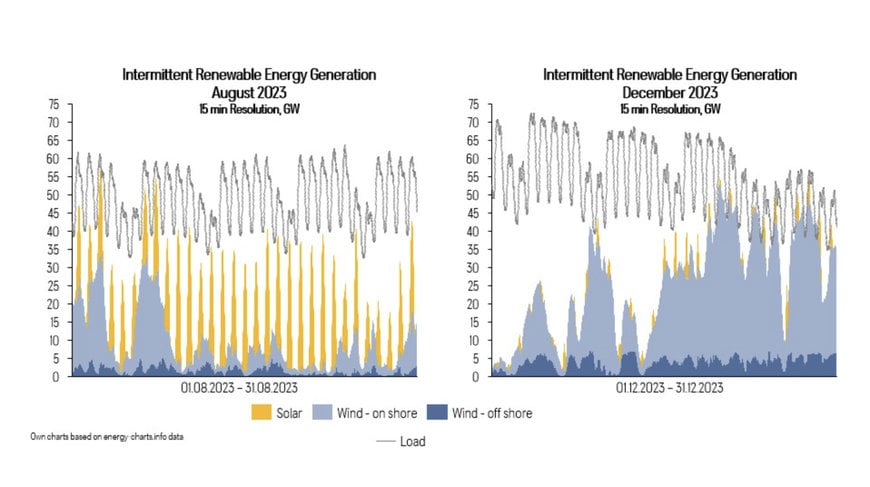
Figure 3: Energy Generation from Wind and Solar, August and December 2023
Closing the gap is getting trickier: Real case example of requirements on controllable power generation.
As an example, an 845 MW CCGT was initially running at full load for more than 4,700 hours per year. In recent years, the generation profile changed to a more variable one, running roughly 2,000 full load hours and starting up more than 100 times per year.
A simplified 15-year TCO calculation comparing a CCGT power plant and an ICE power plant shows that in Conventional Load Profile operation, the CCGT is the cheaper solution. However, applying the more Variable Load Profile, which considers a greater share of intermittent RES in the energy system, the ICE solution becomes cheaper (cf. Figure 4). Assuming that annual runtime might decrease even further to 300-1,000 hours per year, the gap becomes wider (Maximum RES-enabling).
Small increments of power for short durations are becoming the prerequisite in the energy transition.
Turbine power plants are optimized for full-load operation to exhibit high electrical efficiencies. However, since turbine power plants often consist of one or two large turbines, a plant’s efficiency drops significantly for partial load operations/load increments. In the case of engine power plants composed of many small engine modules, partial load operation strategies can differ. To run on load increments, an engine power plant will shut down/not utilize a certain number of superfluous engines. At the same time, the rest will continue to run at maximum load, i.e. maximum efficiency. In conclusion, engine power plants are more suited for frequent partial load operations and demonstrate superior flexibility.
Furthermore, ICEs can respond faster to load changes and do not have significant costs related to start-up, while a CCGT has a minimum up- and downtime, and needs more time to ramp up entailing higher costs. In a world in which conventional power plants primarily provide resilience and security of energy supply, and complement intermittent power generation by PV and wind, fast response times and utmost efficiency, along with versatility, are crucial success factors and enablers of the energy transition.
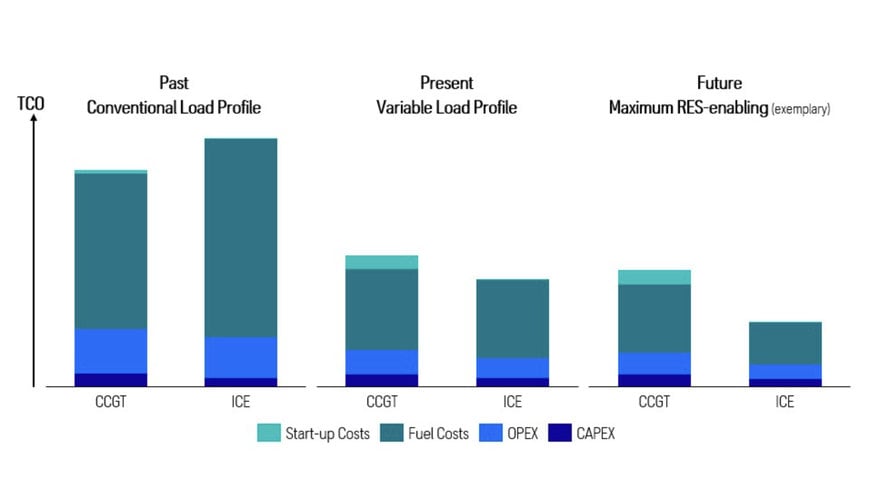
Figure 4: TCO Comparison CCGT vs. ICE3 in Conventional Load Profile (past), Variable Load Profile (Present) and Maximum RES-enabling (future).
Gas engines are flexible champions for short-term supply, and reduce long-term investment costs.
The energy transition has come to stay. Hence, flexible solutions with short start-up times and a high degree of modularity, capable of ramping up many times per week, month and year, and providing the greatest efficiency across a wide output range (and at low cost), are becoming a strategic imperative. They are the enablers of a greener energy future and can generate green power themselves by switching to carbon-free combustion gases. The ICE can therefore be regarded as a future-proof technology which is already mature today.
Due to its modularity, an ICE system can run as many engines as needed at full load while keeping the remaining engines shut down, thus achieving greater efficiency than one large turbine running at partial load. High efficiency reduces the need for primary energy, thus reducing cost and greenhouse gas emissions. At the same time, small increments do not limit the handling of large loads, as major customers already operate backup capacity at the higher end without difficulty (e.g. data centers with 100 MW+ capacity run hundreds of backup ICEs).
One might argue that small-scale turbines are also available and offer the same benefits as ICEs. However, ICEs are available on an industrial scale, making their commissioning faster. And short lead time solutions are crucial for an uncompromised energy transition.
Furthermore, containerized solutions can turn a power plant into a mobile asset. Their capacity can be integrated into the grid where needed to alleviate grid constraints. Later, when it is no longer needed, the power plant can be moved, e.g. when long-term carbon-neutral storage systems become more mature. Moving existing assets instead of decommissioning and building new power plants reduces the investment cost in new capacities and in grid infrastructure. It also reduces the risk of a stranded investment.
Looking at the challenges the energy transition now faces and will be facing in the short-, mid- and long-term, ICEs provide a viable option which is becoming more and more worth considering to meet the challenges of the energy transition. ICE technology can provide clean, cost-effective, and reliable energy for today's and tomorrow's energy systems. In addition, ICE power plant projects can be realized quickly and adopting a modular approach, as containerized gas systems are prefabricated on an industrial scale. Lastly, due to the relatively small unit size (optimized for road transportation) of an ICE module in contrast to a large heavy-duty turbine, redundancy can be achieved with minimal additional investment by simply adding individual units to boost plant capacity.
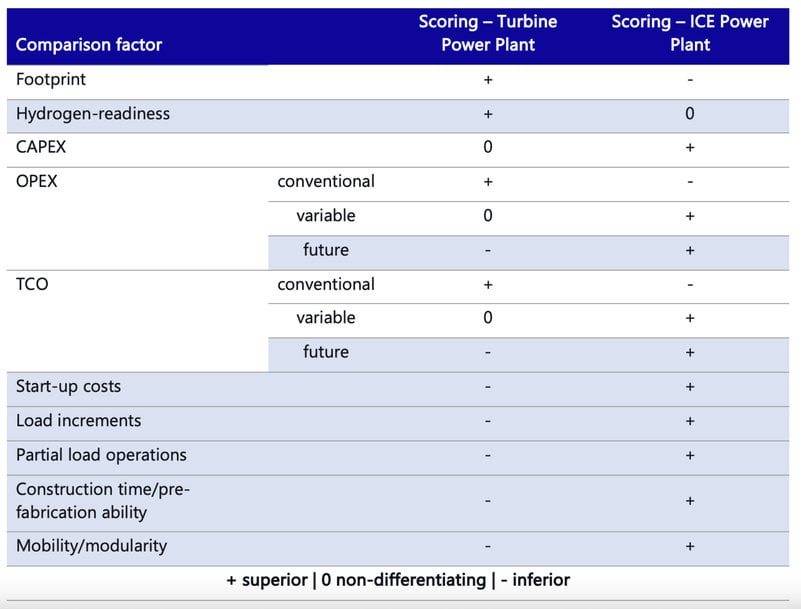
Summary – Qualitative comparison between turbine and ICE power plants along a multitude of different criteria. Key criteria for future power plants are highlighted in blue.
Closing Remarks
This paper focuses on electricity generation from conventional natural gas. Future publications will shed light on combined heat and power generation and the hydrogen readiness of engines and turbines, respectively.
However, the energy system is transforming towards sustainability in an effort to tackle the challenges of climate change (cf. Figure 1). More and more distributed, intermittent renewable capacity is installed, which changes requirements for controllable conventional power plants. From a power generation perspective, conventional power plants must, for example, step in to meet demand during longer periods of bad weather with cloudy skies and little wind, when renewables can only contribute less.

Figure 1: Installed Power Generation Capacity in Germany
Meanwhile, customer consumption patterns are also changing. Electrification of transportation and heating have been increasing in recent years. Overall demand and peak load have changed significantly over the last 20 years. Between 2015 and 2023, electricity demand in Germany was around 460 to 500 TWh per year, with a slightly decreasing trend in recent years. However, depending on the share of hydrogen, the rate of direct electrification, and improved efficiency in the future, electricity demand in Germany is expected to double or even triple between now and 2045 (cf. Figure 2).

Figure 2: Actual and Expected Electricity Consumption in Germany
Furthermore, in networks involving high numbers of PV home systems (with and without battery storage), consumers can be self-sufficient and still draw power from the grid during certain hours or in bad weather. Conventional power generation must still cover these events when large-scale storage systems are no longer an alternative due to their restricted capacity.
While combustion technologies were the heart of the power system in the past, they are now becoming a key enabler, filling the gap between demand and renewable energy production. Consequently, they facilitate the increased integration of intermittent RES into the power system, thereby accelerating the energy transition even further.
However, building up new intermittent renewable energy resources presents its own challenges. The great dependency on wind and solar energy leads to capacities being built on a large scale, requiring vast areas to capture as much energy as possible. Point of generation and demand tend to be inherently divergent in these areas.
Large-scale renewable power plants are usually located well away from regions of high demand. Consequently, the power must be delivered to the point of demand, with an ageing transmission and distribution infrastructure struggling to integrate and bear a higher share of renewables. For example, resource availability means that wind power generation facilities are mainly situated in the north of Germany, while most heavy industry lies in the west and south of the country. As a result, the power must be delivered to these locations, resulting in a need to extend the transmission grid, which in turn requires substantial investment to be covered by the final consumer, and also takes years to plan and build. For example, long approval times and resistance from within the population make the process lethargic, with construction and extension of the power grid often lagging behind the change in load and generation patterns.
If the grid is unable to cope with all the power injected, renewable power generation can become subject to redispatching, while conventional power plants in high-load areas ramp up. This means that renewable power plants have to decrease their output in response to grid constraints, while conventional distributed capacities, operating independently of the weather in high-load regions, can be an alternative solution to cover renewable shortcomings and peak loads until the infrastructure has been enhanced and/or local RES generation catches up, thus lowering the need to transport RES energy over great distances.
Mind and close the gap: Gas power plants close the gap between intermittent RES and increasing demand.
The German government published their Kraftwerksstrategie in February 2024. New gas power stations are in planning to pave the way towards a reliable, climate-neutral power system. Compared to lignite or hard coal, gas combustion has lower CO2 emissions and can become CO2-neutral by burning green hydrogen instead of methane. Gas power plants are also more flexible than coal technologies in terms of start intervals and load changes.
Two types of gas technologies are generally to be considered: Turbines (namely Combined Cycle Gas Turbines (CCGT) & Open-Cycle Gas Turbines) and Reciprocating Internal Combustion Engines (ICEs, namely Medium Speed Reciprocating Engines & High Speed Reciprocating Engines).
Turbine power plants are the technologies of choice for large power generation facilities. High runtime at full load and only a few starts per year result in low Total Cost of Ownership (TCO) and Levelized Cost of Energy (LCOE).
With more intermittent renewable energy production to be balanced, the need for large conventional facilities decreases, and the importance of flexible production profiles increases. Medium-load gas power plants, initially designed to run for 4,000 hours+ at full load, without ramping up and down frequently, run less than 2,000 hours per year with start-up counts in their hundreds. So they have already adjusted their output in line with the availability of renewables. Consequently, TCO and LCOE have increased.

Figure 3: Energy Generation from Wind and Solar, August and December 2023
Closing the gap is getting trickier: Real case example of requirements on controllable power generation.
As an example, an 845 MW CCGT was initially running at full load for more than 4,700 hours per year. In recent years, the generation profile changed to a more variable one, running roughly 2,000 full load hours and starting up more than 100 times per year.
A simplified 15-year TCO calculation comparing a CCGT power plant and an ICE power plant shows that in Conventional Load Profile operation, the CCGT is the cheaper solution. However, applying the more Variable Load Profile, which considers a greater share of intermittent RES in the energy system, the ICE solution becomes cheaper (cf. Figure 4). Assuming that annual runtime might decrease even further to 300-1,000 hours per year, the gap becomes wider (Maximum RES-enabling).
Small increments of power for short durations are becoming the prerequisite in the energy transition.
Turbine power plants are optimized for full-load operation to exhibit high electrical efficiencies. However, since turbine power plants often consist of one or two large turbines, a plant’s efficiency drops significantly for partial load operations/load increments. In the case of engine power plants composed of many small engine modules, partial load operation strategies can differ. To run on load increments, an engine power plant will shut down/not utilize a certain number of superfluous engines. At the same time, the rest will continue to run at maximum load, i.e. maximum efficiency. In conclusion, engine power plants are more suited for frequent partial load operations and demonstrate superior flexibility.
Furthermore, ICEs can respond faster to load changes and do not have significant costs related to start-up, while a CCGT has a minimum up- and downtime, and needs more time to ramp up entailing higher costs. In a world in which conventional power plants primarily provide resilience and security of energy supply, and complement intermittent power generation by PV and wind, fast response times and utmost efficiency, along with versatility, are crucial success factors and enablers of the energy transition.

Figure 4: TCO Comparison CCGT vs. ICE3 in Conventional Load Profile (past), Variable Load Profile (Present) and Maximum RES-enabling (future).
Gas engines are flexible champions for short-term supply, and reduce long-term investment costs.
The energy transition has come to stay. Hence, flexible solutions with short start-up times and a high degree of modularity, capable of ramping up many times per week, month and year, and providing the greatest efficiency across a wide output range (and at low cost), are becoming a strategic imperative. They are the enablers of a greener energy future and can generate green power themselves by switching to carbon-free combustion gases. The ICE can therefore be regarded as a future-proof technology which is already mature today.
Due to its modularity, an ICE system can run as many engines as needed at full load while keeping the remaining engines shut down, thus achieving greater efficiency than one large turbine running at partial load. High efficiency reduces the need for primary energy, thus reducing cost and greenhouse gas emissions. At the same time, small increments do not limit the handling of large loads, as major customers already operate backup capacity at the higher end without difficulty (e.g. data centers with 100 MW+ capacity run hundreds of backup ICEs).
One might argue that small-scale turbines are also available and offer the same benefits as ICEs. However, ICEs are available on an industrial scale, making their commissioning faster. And short lead time solutions are crucial for an uncompromised energy transition.
Furthermore, containerized solutions can turn a power plant into a mobile asset. Their capacity can be integrated into the grid where needed to alleviate grid constraints. Later, when it is no longer needed, the power plant can be moved, e.g. when long-term carbon-neutral storage systems become more mature. Moving existing assets instead of decommissioning and building new power plants reduces the investment cost in new capacities and in grid infrastructure. It also reduces the risk of a stranded investment.
Looking at the challenges the energy transition now faces and will be facing in the short-, mid- and long-term, ICEs provide a viable option which is becoming more and more worth considering to meet the challenges of the energy transition. ICE technology can provide clean, cost-effective, and reliable energy for today's and tomorrow's energy systems. In addition, ICE power plant projects can be realized quickly and adopting a modular approach, as containerized gas systems are prefabricated on an industrial scale. Lastly, due to the relatively small unit size (optimized for road transportation) of an ICE module in contrast to a large heavy-duty turbine, redundancy can be achieved with minimal additional investment by simply adding individual units to boost plant capacity.

Summary – Qualitative comparison between turbine and ICE power plants along a multitude of different criteria. Key criteria for future power plants are highlighted in blue.
Closing Remarks
This paper focuses on electricity generation from conventional natural gas. Future publications will shed light on combined heat and power generation and the hydrogen readiness of engines and turbines, respectively.
Download the whitepaper
www.mtu-solutions.com

